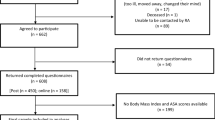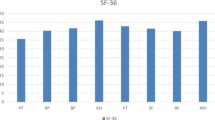Abstract
Evidence suggests that magnetic resonance imaging (MRI) allows accurate diagnosis of meniscal and ligamentous injuries of the knee. However the link between improved diagnosis through MRI and improved patient quality of life (QOL) has yet to be shown. Previous studies almed at establishing this link have found no significant improvements in health related quality of life (HRQOL) as measured by the Rosser classification and index. This paper presents the results of three HRQOL questionnaires (SF-36, Rosser and EuroQol©) used to measure health change in 332 patients referred for MRI of the knee. Before imaging, patients reported poorer HRQOL than the general population on two of the three questionnaires (SF-36 and EuroQol©). The same two questionnaires recorded significant improvements in patient health at six months, although patients' health had not yet reached that experienced in the general population. There was evidence to suggest that the index values attached to the Rosser classification made it unresponsive in this group of patients, which may have predisposed the null results of previous studies of the influence of MRI on HRQOL. Some evidence is provided to suggest that the EurolQol© may be less responsive in assessing change in health status than the SF-36.
Similar content being viewed by others
References
Reicher MA, Rauschning W, Gold RH, et al. High resolution magnetic resonance imaging of the knee joint: normal anatomy.Am J Roentgenol 1985;145: 895–902.
Mackenzie R, Logan BM, Shah NJ, et al. Direct anatomical-MRI correlation: the knee.Surg Radiol Anat 1994;16: 183–192.
Fischer SP, Fox JM, Del Pizzo W, et al. Accuracy of diagnosis from magnetic resonance imaging of the knee: a multi centre analysis of one thousand and fourteen patients.J Bone Joint Surg 1991;73A: 2–10.
Mackenzie R, Hollingworth W, Dixon AK. Quality of life assessments in the evaluation of magnetic resonance imaging.Qual Life Res 1994;3: 29–37.
Teasdale GM, Hadley DM, Laurence A, et al. Comparison of magnetic resonance imaging and computed tomography in suspected lesions in the posterior cranial fossa.BMJ 1989;299:349–355.
Szczepura AK, Fletcher J, Fitz-Patrick JD. Cost effectiveness of magnetic resonance imaging in the neurosciences.BMJ 1991;303: 1435–1439.
Dixon AK, Southern JP, Teale A, et al. Magnetic resonance imaging of the head and spine: effective for the clinician or the patient?BMJ 1991;302: 79–82.
Dixon AK, Wheeler TK, Lomas D, Mackenzie R. Computed tomography or magnetic resonance imaging for axillary symptoms following treatment of breast carcinoma? A randomised trialClin Radiol 1993;48: 371–376.
Mackenzie R, Lomas DJ, Villar RN, et al. Magnetic resonance imaging for the problem knee: A randomised clinical trial.Br J Radiol 1993;66 (Suppl.): 21.
Rosser R, Kind P. A scale of valuations of states of illness is there a social consensus?Int J Epidemiol 1978;7: 347–358.
Gudex C, Kind P.The QALY Toolkit. York: Centre for Health Economics, University of York, 1988. [Discussion paper 38].
Kind P, Gudex CM. Measuring health status in the community: a comparison of methods.J Epidemiol Community Health 1994;48: 86–91.
Spiegelhalter DJ, Gore SM, Fitzpatrick T, et al. Quality of life measures in health care. III: resource allocation.BMJ 1992;305: 1205–1209.
Carr-Hill RA. Assumptions of the QALY procedure.Soc Sci Med 1989;29: 469–477.
Donaldson C, Atkinson A, Bond J, Wright K. Should QALYs be program specific.J Health Econ 1988;7: 239–257.
Gore SM. Statistics in question. In: Gore SM, Altman DGStatistics in practice London: British Medical Association, 1982: 27–94.
Goin JE, Hermann GA. The clinical efficacy of diagnostic imaging evaluation studies: problems, paradigms and prescriptions.Invest Radiol 1991;26: 507–511.
Todd C, Bradley C. The design and development of psychological scales. In: Bradley C, ed.Handbook of psychology and diabetes: A guide to psychological measurement in diabetes research and practice. Chur, Switzerland: Harwood Academic, 1994; 15–42.
Guyatt G, Walter S, Norman G. Measuring change over time: Assessing the usefulness of evaluative instruments.J Chron Dis 1987;40: 171–178.
Ware JE, Sherbourne CD. The MOS 36-item Short-Form health survey (SF-36).Med Care 1992;30: 473–482.
Jenkinson C, Wright L, Coulter A.Quality of life measurement in health care: A review of measures and population norms for the UK SF-36. Oxford: Health Services Research Unit, 1993.
EuroQol© Group. EuroQol©—a new facility for the measurement of health-related quality of life.Health Policy 1990;16: 199–208.
Brazier JE, Harper R, Jones NMB, et al. Validating the SF-36 health survey questionnaire: new outcome measure for primary care.BMJ 1992;305: 160–164.
Garratt AM, Ruta DA, Abdalla MI, et al. The SF 36 health survey questionnaire: an outcome measure suitable for routine use within the NHS?BMJ 1993;306: 1440–1444.
Ruta DA, Abdalla MI, Garratt AM, et al. SF 36 health survey questionnaire: I. Reliabiliity in two patient based studies.Quality in Health Care 1994;3: 180–185.
Garratt AM, Ruta DA, Abdalla MI, Russell IT. SF 36 health survey questionnaire: II. Responsiveness to changes in health status in four common clinicial conditions.Quality in Health Care 1994;3: 186–192.
Kind P. Practical and methodological issues in the development of the EuroQol: The York experience. In: Albrecht GL and Fitzpatrick R, eds.Advances in medical sociology Vol 5: Quality of Life. Greenwich, Connecticut: JAI Press, 1995; 219–253.
Ware JE, Snow KK, Kosinski M, Gandek BSF-36 Health survey. Manual and interpretation guide. Boston: The Health Institute, New England Medical Centre, 1993.
Interim values provided by the Research Group on the Measurement and Valuation of Health (MVH group), University of York [Personal communication, MVH Group, June 1994]
Kind P, Gudex C.The HMQ: measuring health status in the community. York: Centre for Health Economics, University of York, 1991 [Discussion paper no. 93]
Jenkinson C, Coulter A, Wright L. Short form 36 (SF 36) health survey questionnaire: normative data for adults of working age.BMJ 1993;306: 1437–1440.
University of York,Mimeo. ‘The Measurement and valuation of health’. May 1994.
Williams A, Kind P. The present state of play about QALYs. In: Hopkins A, ed.Measures of the quality of life, and the uses to which such measures may be put. London: RCP publications, 1992; 21–33.
Brazier J, Jones N, Kind P. Testing the validity of the Euroqol and comparing it with the SF-36 health survey questionnaire.Qual Life Res 1993;2: 169–180.
Lydick E, Epstein RS. Interpretation of quality of life changes.Qual Life Res 1993;2: 221–226.
Hurst NP, Jobanputra P, Hunter M, et al. Validity of EuroQol—A generic health status instrument—in patients with rheumatoid arthritis.Br J Rheumatol 1994;33: 655–662.
Author information
Authors and Affiliations
Rights and permissions
About this article
Cite this article
Hollingworth, W., Mackenzie, R., Todd, C.J. et al. Measuring changes in quality of life following magnetic resonance imaging of the knee: SF-36, EuroQol© or Rosser index?. Qual Life Res 4, 325–334 (1995). https://doi.org/10.1007/BF01593885
Issue Date:
DOI: https://doi.org/10.1007/BF01593885




